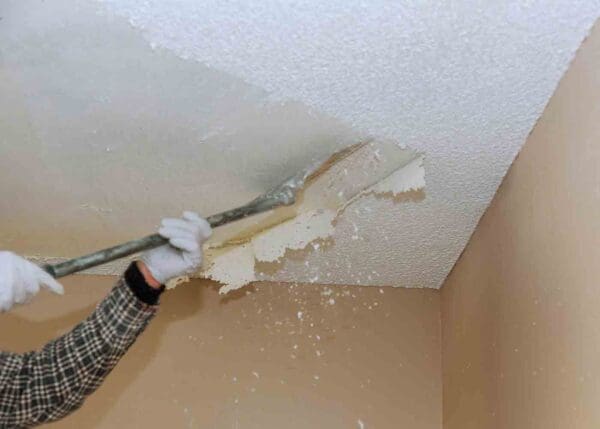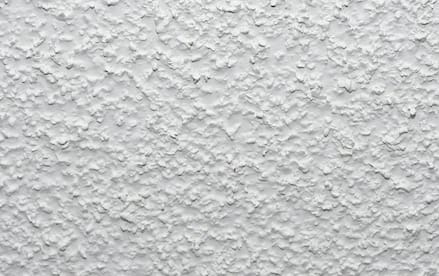01. Is There Asbestos in Popcorn Ceilings?
Do Popcorn Ceilings Have Asbestos?
Popcorn ceilings were popular from 1945 to the early 1990s. This textured ceiling covering was useful for acoustic insulation and covering up imperfections. However, popcorn ceiling material often included the mineral asbestos.
During this time, asbestos was commonplace in building materials, including popcorn ceilings. The mineral was often included in construction materials because it is fire-resistant, cheap and strong.
Popcorn ceiling coverings contained anywhere from one to ten percent asbestos.
How Common Is Asbestos in Popcorn Ceilings?
Popcorn ceilings and other products used throughout the 20th-century commonly contained asbestos. Reports show popcorn ceiling products installed from 1945 until the early 1990s likely contained asbestos.
The Environmental Protection Agency (EPA) banned hazardous pollutants from ceiling coverings in 1973 with the National Emission Standards for Hazardous Air Pollutants (NESHAP).
However, researchers note popcorn ceiling materials may have still contained asbestos after the ban. Existing inventories of asbestos products were exempt from the ban and workers may have continued to use them. Some reports indicate asbestos may have been present in popcorn ceiling material stockpiles as late as the 1990s.
Individuals who own homes built before the 1990s should assume asbestos is present in all popcorn ceilings. Materials installed after 1995 likely did not contain asbestos.
Other names for popcorn ceiling products include:
- Acoustic ceiling
- Blown-on ceiling
- Cottage-cheese ceiling
- Spray-on ceiling
- Stipple ceiling
- Stucco ceiling
- Textured ceiling
If these ceilings were not replaced, homes and other buildings may still contain asbestos.
02. Addressing Asbestos Ceilings
What to Do if Your Popcorn Ceilings Have Asbestos
Homeowners who suspect their popcorn ceilings were installed before the early 1990s should hire a professional to test, remove/encapsulate and dispose of the mineral. Asbestos contractors should be the only people handling asbestos. Sanding, painting or patching a popcorn ceiling could disturb asbestos fibers and create dangerous asbestos dust.
For homes with asbestos ceilings, a professional may choose to remove or encapsulate the materials.
- Asbestos removal involves carefully ridding the building of asbestos products. A licensed professional will then safely and legally dispose of the asbestos.
- Asbestos encapsulation covers up asbestos-containing products to avoid fibers releasing into the air.
If a homeowner suspects asbestos is in their home, they should not attempt to remove or encapsulate it on their own. The first step should be to hire a licensed abatement contractor.
If asbestos materials may have been disturbed already, homeowners can take steps to help prevent exposure. To help prevent asbestos exposure before the abatement professional arrives, homeowners can:
- Remove pets and people from the area
- Shut off all vents and close all doors to the affected area
- Wet the area to keep fibers out of the air
The safest way to deal with asbestos is to leave it to professionals. Doing so will protect friends and family from inhaling harmful asbestos fibers.
How to Test Your Ceiling for Asbestos
Homeowners can test their popcorn ceilings for asbestos by hiring a reliable and licensed contractor. Asbestos professionals are trained in state and federal regulations for proper handling of asbestos.
A contractor will conduct a thorough inspection of any broken or damaged material that may contain asbestos. If renovation is underway or planned, the contractor should inspect these areas as well.
They will visually inspect materials for damage. The contractor will also take samples of the ceiling and suspected asbestos materials and send them away for lab testing. If asbestos is discovered, a mitigation and removal plan will be put together.
How to Remove Popcorn Ceilings With Asbestos
A licensed asbestos abatement contractor can conduct asbestos removal. Homeowners, landlords, tenants or general contractors should not attempt removal on their own.
To determine how to deal with asbestos in the ceiling, contractors will assess their condition and friability. Friability refers to the “crumbliness” of the product.
- Highly friable asbestos products are the most dangerous, as they are the most likely to release fibers into the air. Professionals may recommend removing these products.
- For low friability products in good condition, contractors may recommend encapsulation.
For a complete asbestos popcorn ceiling removal, the contractor will first shut off all ventilation to the affected area. Typically, the products will be wet down to prevent airborne fibers. The products are then removed.
Each state has regulations for asbestos disposal. A licensed contractor will safely dispose of the products, ensuring they do not harm anyone else.
03. Health Risks of Asbestos in Ceilings
The Dangers of Asbestos in Popcorn Ceilings
Disturbed or damaged asbestos popcorn ceilings can release fibers into the air. Asbestos fibers are dangerous if inhaled or ingested. Once asbestos is in the body, serious health conditions may develop.
Health Risks of Asbestos Exposure From Popcorn Ceilings
Asbestos fibers can embed into the linings of internal organs. Over time, these fibers may cause irritation and scarring. This irritation can cause several dangerous health problems. The most serious of these is mesothelioma cancer. Other conditions include asbestosis and asbestos lung cancer.
In one case study, researchers examined the exposure of a woman who lived with asbestos ceilings for 30 years. Persistent water damage released asbestos dust into the air. The subject began experiencing heavy coughing in the 1990s. In 2010, she was diagnosed with lung cancer. She subsequently was diagnosed with lung scarring consistent with asbestosis.
Asbestos diseases can take 10 to 50 years to develop after initial exposure. While there is no safe level of asbestos exposure, repeated exposure may increase the risk of developing an asbestos disease.
Who Is Most at Risk From Asbestos in Popcorn Ceilings?
There are several ways someone may come into contact with asbestos in popcorn ceilings. These higher-risk groups include:
- Construction professionals: Individuals are likely to come into contact with asbestos popcorn ceilings during construction, renovation or demolition. This is occupational exposure.
- Homeowners and families: Asbestos ceilings in homes may expose an entire family to the mineral. Popcorn ceiling removal or encapsulation can mitigate at-home asbestos exposure.
People working or living with asbestos are at the highest risk of asbestos exposure from popcorn ceilings. However, individuals should also be aware of secondary exposure. Secondary exposure occurs when coming into contact with someone who may have asbestos fibers on their person. This often happens with spouses of asbestos workers.
Owners of older homes should test popcorn ceilings and other materials for asbestos. Professionals can test for the mineral and recommend a mitigation plan to prevent exposure.




